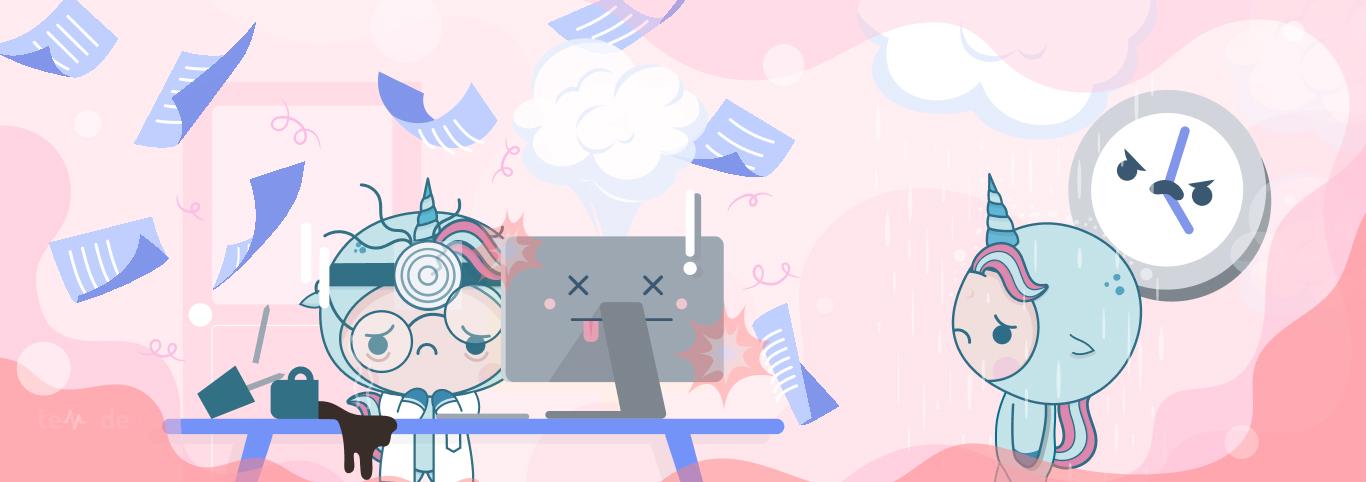
A recent national survey of Physicians found the average Doctor is still pretty unhappy with Electronic Health Record (EHR) software. In fact, the average Physician gave it a failing grade of "F."
EHR unhappiness is tied to a much bigger issue, Physician burnout. Burnt-out Doctors are at higher risk of malpractice and medical error. Their overall quality of patient care is lower, and patient satisfaction scores drop.
Luckily, EHR unhappiness isn't inevitable. Doctors are less likely to fail their EHR when it's user-friendly. In addition, researchers found Physicians are happier with specialized EHR software instead of one-size-fits-all solutions.
If your Physicians and administrative staff would give your current EHR an "F" grade, you may have a problem. The following 10 signs are among the most common reasons you may need to replace your practice software. Contact TempDev for help fixing the issues or replacing your EHR.
1. Poor Practice Management Capabilities
Disorganized practice management is noticeable to patients. It definitely catches patient attention when their appointments are rescheduled. They notice when they wait for more than 7-10 minutes in the waiting room.
In fact, studies show that 96% of patient complaints are related to customer service issues—not quality of care. Practice management plays an integral role in a patient's overall perception of care quality. Better practice management benefits everyone by creating greater efficiency and lower operating expenses.
2. Minimal Integrations
If the EHR offers limited integrations with practice management (EPM) billing software, patient portals, and a mobile solution, you're missing out on a lot of opportunities for greater efficiency.
Switching to an EHR like NextGen offers built-in integrations with an ecosystem of solutions. Your practice could gain integration with solutions for:
Telehealth services like OTTO
Patient acquisition and retention
Aftercare instructions
3. Wrong-Sized Software for Your Practice
Trying to use an EHR that's designed for a bigger or smaller healthcare organization can be a source of frustration. Also, trying to make an acute system work in an ambulatory setting never serves physicians well. The goal is to right-size your EHR software and find something that's aligned with your specialty.
Some common signs of wrong-sized software include:
Excessive software costs
Limited capabilities and features
No multi-site capabilities
Difficult administration
Limited specialties
Complex customization and configuration
If the software is too expensive and you need an expert to make any kind of change, it may be too large. If you have too few features and capabilities, the software may be too small. In either case, there's a benefit to right-sizing your solution.
4. Minimal Productivity Gains
Studies show the average family practice Physician works 47 hours each week. 33 of those hours are spent on face-to-face patient care. On average, Physicians do 14 hours of administrative work. If your EHR software hasn't diminished the burden of manual work on care providers and admin staff, you're missing an opportunity to boost productivity.
EHR features can significantly improve productivity in every aspect of the practice workflow. In many cases, productivity gains are also tied to other, related benefits such as lower error rates and better outcomes. An automated appointment reminder feature can save 10 hours a week in manual reminder calls and $150,000 in missed appointments.
5. No Patient Self-Service Capabilities
Patients are increasingly used to mobile health — or, mHealth — technologies. 90% of patients use at least one medical app, according to a recent survey. The most common reasons are health information and provider reviews. 87% of people say they're comfortable using apps to share medical info with a Doctor.
If your EHR doesn't offer self-serve patient mobile apps and kiosk technologies, you're missing opportunities for patient satisfaction and engagement. Offering a kiosk in the waiting room can increase check-in efficiency and decrease wait times.
6. Unsatisfactory Vendor Support
If your EHR frequently goes down or you're left waiting days or even weeks for an answer, you may have a serious case for better vendor support. Both EHR vendors and implementation partners should have a strong record of post-sales client support.
7. You're Still Using Paper
Maybe your EHR just doesn't fit your workflows. Or, perhaps it's missing critical features to capture patient registration or billing. Even more frustrating, maybe your all-in-one solution goes down so frequently you have to switch between software and paper continually.
Paper records are costlier and more prone to error than EHR software. There's a larger margin for HIPAA violations. They're less secure, more difficult to locate, and more challenging to use for billing. If you're not fully electronic, it may be time to look at an EHR that can get you off paper — permanently.
8. Extensive Glitches
EHR glitches aren't just annoying for admin staff and Physicians. They're a huge risk. In some cases, EHR glitches have even led to patient deaths.
Recently, a brain aneurysm patient died after an EHR glitch prevented a brain scan request from ever reaching the imaging department. This sad case isn't unique — EHR glitches can have devastating consequences when information is lost. Medical error can also occur when EHR glitches mess up drug dosing information or drug interactions.
An EHR glitch doesn't just lead to excessive work or frustration. It can have a negative impact on the quality of patient care and health outcomes.
9. Staff Work-Arounds
A recent Harvard University survey of hospital clinicians found that teams "pervasively" used EHR workarounds. Sometimes, handwritten notes were used as a "cognitive aid." Other workarounds occurred because the EHR was just too clunky or time-consuming.
Staff may invent workarounds because of inconsistent workflows or EHR usability issues. Whatever the reason, they're a sign that care providers and staff are unhappy with your current software, and a new solution may be in order.
10. Missing Features
In some cases, small practices are shocked to learn about the latest generation of EHR features that can solve common workflow and compliance issues. For example, the NextGen NextPen is a smartpen technology that can transfer handwritten Physician notes and voice dictation into the EHR software.
In other cases, automatic translation capabilities can provide self-service patient check-in from a kiosk in the waiting room for patients whose primary language isn't English. If you feel you're missing out on critical features, there's a good chance your current EHR is falling significantly short.
Is it Time for New EHR?
EHR can be an opportunity to address many common challenges in medical practices. EHR replacement can tackle the long-standing issue of Physician dissatisfaction with EHR, but it can also be used to correct other common problems. The right EHR can address quality metrics, usability woes, employee efficiency, and the revenue cycle.
TempDev has an all-star team of experienced EHR and Electronic Practice Management (EPM) specialists who can use an EHR project to optimize all areas of your organization. Click here to start a conversation.
Interested?
Agree with our point of view? Become our client!
Did you enjoy this read? Feel free to share it with your contacts.







